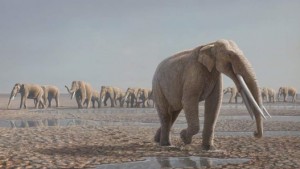Arabian Footprints Show Behaviour in Primitive Elephant Herd
Palaeontologists have been able to build up a good understanding of the evolution of the elephant family (Proboscidea – elephants and their close relatives), due to the extensive amount of body fossils associated with these tusked creatures. Footprints and other trace fossils are extremely rare. However, a remarkable set of primitive elephant trackways, dated to the Late Miocene Epoch, discovered on the Arabian desert are giving scientists new insights into primitive elephant behaviour.
Elephant Trackways
The paper, detailing the research work, on what are believed to be the oldest elephant trackway ever discovered has been published in the scientific journal “Biology Letters”. The beautifully preserved tracks, have been left by thirteen primitive elephants, ancestors of the extant species found in Asia and Africa today. These trace fossils dated to around seven million years ago are the earliest, direct evidence of how the ancestors of modern elephants interacted socially. These fossils are the oldest evidence of an elephant herd.
Vertebrate palaeontologist at the Museum for Natural History (Berlin), Faysal Bibi commented:
“Basically, this is fossilised behaviour. This is an absolutely unique site, a really rare opportunity in the fossil record that lets you see animal behaviour in a way you couldn’t otherwise do with bones or teeth [body fossils].“
Fossil Trackway
The fossil trackway is located in the UAE (United Arab Emirates), is is known as Mleisa 1. During the Late Miocene, this area was not like the desert environment found today. A large, slow flowing river, meandered across a lush, verdant plain and the area teemed with life. As well as elephants there were ancient hippos, antelopes, giraffes, monkeys and ostriches. Along the river bank, crocodiles and turtles basked in the sun, ready to enter the slow flowing river to feed on the many types of fish species that lived there.
This ecosystem shares affinities with fossil assemblies found further south in Africa, although scientists have also recorded similarities with Asian and Europe species known from the Late Miocene.
The tracks near to the city of Abu Dhabi, had been known to locals for many years. Some had thought these were the tracks of dinosaurs or perhaps from mythical creatures, stories of which are passed down from one generation to another as folk tales. However, although the site had been studied back in 2001, it was only when in January 2011, once the trackways were studied from the air, that their true nature was revealed.
Commenting on the importance of the aerial photography, Brian Kraatz a researcher at the Western University of Health and Sciences (Pomona, California) stated:
“Once we saw it aerially, it became a much different and clearer story. Seeing the whole site in one shot meant we could finally understand what was happening.”
The fossilised tracks cover an area of approximately five hectares, an area of land a fraction bigger than London’s Wembley Football Stadium. At first, due to the scale of the site, it was difficult for ichnologists (scientists who specialise in studying trace fossils such as trackways), to understand precisely what the footprints represented.
The study team noted that while these large animals were members of the Proboscidea – just like modern elephants, they did look very different. Of the three kinds of prehistoric elephant known to roam that area in the Late Miocene, the one that most likely made the trackways was Stegotetrabelodon syrticus,the earliest known member of the elephant family.
An Artists Impression of the Herd of S. syrticus
Picture credit: Mauricio Anton
Stegotetrabelodon syrticus
The picture above shows a reconstruction of the Stegotetrabelodon syrticus herd that likely made the tracks in the Arabian desert. These primitive elephants had a pair of tusks in the lower jaws as well as tusks in the upper jaw.
The trackways stretch up to about 260 metres long, making them, the most extensive and longest ever recorded for mammals known.
Actually mapping these footsteps proved challenging, since the individual tracks are each only about 15 inches (40 centimetres) wide, too small to show up in satellite imagery. To do so, researchers mounted a pocket digital camera onto a kite, stitching the hundreds of pictures it took into a single large mosaic image that gave a broad overview of the site.
Analysis of the footsteps suggests they belonged to a herd of at least thirteen elephants of different sizes and ages that walked through mud, leaving behind tracks that hardened, were buried, and then re-exposed by erosion.
The researchers also discovered tracks from a solitary animal (believed to be a male) traveling in a different direction from the herd. These suggest the extinct giants divided into solitary and social groups, just as modern African elephants do today. Also, these ancient pachyderms might have structured themselves along lines of males and females just as their modern relatives do, with the males leaving the herd to live alone.
Scientists hope to return to the area in the future to continue their studies, and to also look for more body fossils, helping them to piece together more information about the diversity of mammals in this region during the Late Miocene, in a bid to understand how mega fauna from Africa spread into Asia and Europe.
A spokesperson from Everything Dinosaur, commented that it was fascinating to read about this new research into elephant behaviour, especially after the team had just finished reviewing new baby Mammoth models (Papo) so collectors could make up their own prehistoric elephant herds.
To view the Papo prehistoric animal model range: Papo Prehistoric Elephant Models and Dinosaurs.






Leave A Comment